|

District: Nalanda
Commissionary: Patna
Headquarters: Biharsharif
Sub-divisions: Biharsharif, Hilsa, Rajgir
Population: 19,97,995 (20 lakh)
Area: 2,361.70 square km
Height above sea level: 67 metres
Temperature:
Summer: Maximum: 48° C Minimum: 18°
C
Winter: Maximum: 28° C Minimum: 15°
C
Rainfall: 120 cm
Best time to visit the place: November to
February
Road connectivity: 93 km away from Patna;
12 km from Rajgir; 89 km from Bodh Gaya (via Gaya)
Rail connectivity: Nearest railway station:
Nalanda
Main railway station: Patna
Air connection: Nearest airport — Patna
and Gaya
Main Spots of tourist Interest
Histrocial Importance
Between 5th century AD and 12th century AD Nalanda had a
world-renowned university, where besides Indian scholars,
Sri Lankans, Tibetans, Mangolians, Chinese, Korean and intellectuals
from Southeast Asia used to study here. Renowned Buddhist
philosopher Nagarjun, logicist Dignag and Brahmin scholar
Dharampal used to teach here. In both ‘Mahayan’
and ‘Hinayan’ Buddhist schools subjects like Veda,
Philosophy, Logic, Grammar, Maths, Astrology and Medicine
were taught. Besides Hieun-Tsang, many Chinese scholars had
had come here to study.
Many emperors and kings also got constructed temples at the
Nalanda University. ‘Ashoka the Great’ built a
‘Vihar’; emperor Kumargupta set up arts and crafts
university; king Harshavardhan of Kannauj got constructed
temples. ‘Ashoka the Great’ got constructed a
‘Vihar’; emperor Kumargupta set up arts and crafts
university; king Harshavardhan of Kannauj got constructed
a copper statue of Lord Buddha, which had height of 25 metres.
According to historians, Harshavardhan and Kumarvardhan played
a major role in developing this seat of knowledge.
Due to thrift between Pal and Sen dynasty, the decline of
Nalanda University started. In 13th century AD Afghanis looted
and plundered this university. It is said that Gautam Buddha
frequented this place. He had come to Nalanda for treatment
of his joint pain at the hot spring of Nalanda. The ash of
Gautam Buddha is kept in a sacred stupa, which was constructed
by Ashoka. It is believed that Nalanda was birthplace of main
disciple of Lord Buddha, Sariputra. At that time, the place
was lush green and filled with Mango orchards.
According to Hieun Tsang, Lord Buddha in his previous birth
was King Boddhistava. At that time Nalanda was its capital.
Due to his generous attitude this place was called Nalanda
— meaning donation without any obstacle. The second
belief associated with this name is that in ancient time Lotus
(also called Nal in Hindi) was found here in abundance that
is why it is called Nalanda.
Places of Tourist Interests
Ruins of Nalanda University
Loaction: The ruins of Nalanda
University are located 93 km southeast of Patna and 12 km
north of Rajgir, near Badgaon.
Importance: According to Jain
religious books, Nalanda was a satellite township of Rajgir.
Gupta kings (415-455 AD) got constructed this university.
During 5th century AD the place was most important seat of
Buddhist learning. During its zenith there were six universities,
eight-storied Vihar, five huge temples and three big libraries.
Conversion of Mahavihar into University:
Slowly for Buddhists Nalanda Mahavihar became a pilgrimage
spot. At the  Mahavihar
besides analysis of tradition and culture of other religions,
their religious books and philosophies were studied. Debates
and seminars were held on various topics. Subsequently, Nalanda
Mahavihar changed into an international university. At its
start, it became a residential university. During that time
the place was bounty with vegetation and mango orchards. Here
Buddhist religious book (Mahayana and Hinayana), Veda, Logic,
Grammar and Medicines were taught. Emperor Harshavardhan and
kings of Pal dynasty provided grants to this university. The
varsity was a reputed seat of learning where scholars from
all round the country visited the place. Chinese traveller
Hieun-Tsang (629-645 AD) joined the varsity as a student and
he was popularly known as ‘Mokshdeva’. Mahavihar
besides analysis of tradition and culture of other religions,
their religious books and philosophies were studied. Debates
and seminars were held on various topics. Subsequently, Nalanda
Mahavihar changed into an international university. At its
start, it became a residential university. During that time
the place was bounty with vegetation and mango orchards. Here
Buddhist religious book (Mahayana and Hinayana), Veda, Logic,
Grammar and Medicines were taught. Emperor Harshavardhan and
kings of Pal dynasty provided grants to this university. The
varsity was a reputed seat of learning where scholars from
all round the country visited the place. Chinese traveller
Hieun-Tsang (629-645 AD) joined the varsity as a student and
he was popularly known as ‘Mokshdeva’.
The university was at its prime till 12th century AD and
its popularity had reached even East Asia. According to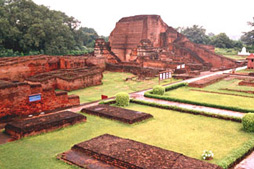 historical sources, Nalanda University was a graduate-level
institution, where 8,500 students and 1,510 teachers stayed
together. The student teacher ratio was 1:5. Due to this,
the teachers maintained person-to-person contact in the university.
Later, Nalanda University was handed over to Buddhist monks,
whose vice-Chancellor was a renowned monk, Sheelbhadra.
historical sources, Nalanda University was a graduate-level
institution, where 8,500 students and 1,510 teachers stayed
together. The student teacher ratio was 1:5. Due to this,
the teachers maintained person-to-person contact in the university.
Later, Nalanda University was handed over to Buddhist monks,
whose vice-Chancellor was a renowned monk, Sheelbhadra.
From 415-55 century AD Kumargupta got constructed a Buddha
Vihar. Initially the Buddhist monks lived here. After Kumargupta
many emperors and kings provided aid to the university. Chinese
traveller Itisung says there were more than 200 villages,
which provided help to the university. It is believed that
between 1199 and 1235 AD Mohammad Bin Bakhtiyar Khilji attacked
the university and destroyed it.
Ruins of Nalanda University:
The archaeological finds of Nalanda University are spread
in 14 hectares. During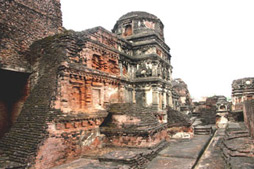 excavation it was found that there was separate hostels, lecture
halls, puja rooms, muths, stupas, ponds and sleeping rooms
for students and teachers. The road leading to the excavation
site is located near the wall of left Muth no. 1 and it passes
between Muth no. 4 and 5. As soon as the tourist enters the
place from the eastern door, he finds himself amidst a series
of temple and Chaityas at the west and he finds Viharas and
Muth in the east. Here stupas of Gupta era (319-550 century
AD) are also found. During excavation it was found that on
a few foundation structures were later developed or beside
them temples were constructed.
excavation it was found that there was separate hostels, lecture
halls, puja rooms, muths, stupas, ponds and sleeping rooms
for students and teachers. The road leading to the excavation
site is located near the wall of left Muth no. 1 and it passes
between Muth no. 4 and 5. As soon as the tourist enters the
place from the eastern door, he finds himself amidst a series
of temple and Chaityas at the west and he finds Viharas and
Muth in the east. Here stupas of Gupta era (319-550 century
AD) are also found. During excavation it was found that on
a few foundation structures were later developed or beside
them temples were constructed.
A temple has been constructed at the pinnacle of the most
important stupa at Nalanda. The temple, which has a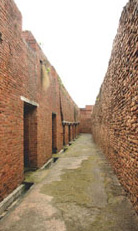 huge statue, can be reached by a flight of steps that was
constructed in 6th century AD.
huge statue, can be reached by a flight of steps that was
constructed in 6th century AD.
From south to north there are several Muths, who almost are
same in appearance. Among them the most important spot is
— spot no. 1, whose main door is situated west of assembly
hall. The structure is supported by pillars. Later, the assembly
hall was segregated by wall.
Primarily this is double-storied building, which is known
from steps constructed in southeast. In the courtyard there
is a statue of Gautam Buddha. There is a wall in each muth.
The ruins of the university are spread in a vast area. The
stupas here have been made remade twice or thrice. Near the
main stupa there are small stupas, platform and small statues,
which even today signifies the grandeur of Nalanda University.
Main Temple: Among an array
of temples, at the southern point there is a main temple,
which is a huge structure. The temple is in the middle of
a courtyard and is surrounded by small stupas. During excavation
it was found that small and big structures were constructed
near the main structure. At present the structure shows that
seven times construction had been done at the site.
Vihar 1 A and 1 B, are on the eastern side of the main temple
and are remains of the two Viharas. Their doors are on the
northern side. At the front side there is a courtyard made
up of brick. Around the structure there are small rooms. At
the southern end of the structure there is a room for statues.
Vihar 1 B has a courtyard made up of brick and at the northwest
corner there is an octagonal well. The ‘garhs’
at the corner of the courtyard shows that the two Vihars were
constructed on the ruins.
In a recent excavation the entrance of Nalanda University
has been found at Badgaon. Mound had also been found here
which local people call as ‘Dhamma Khand’. The
archaeological finds suggest that besides Mauryas and Kushans
Suryas also ruled here.
Zuafardih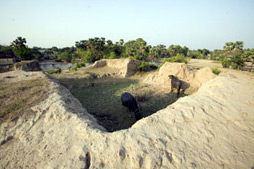
Location: Zuafardih village
is located 3 km away from ruins of Nalanda University. In
a recent archaeological excavation remains of Mauryan era
dating back to 600 century AD have been found.
Importance: While the remains
of Nalanda University are of 4th century AD, but that of Zuafardih
dates back to 100 years. The Archaeological Survey of India
(ASI) during excavation had found a stupa and towards its
east a pond. Besides these, here terracotta, pieces of glass
and copper bangles, bones and arrow made of iron and bowl-shaped
utensils had been found. This spot is spread in 10 acres.
The stupa here is same as that have been found at Vaishali,
Lauriya and Nandangarh.
Sarilchak
Location: Sarilchak village
is located 1.5 km away from ruins of Nalanda University. This
place is of archaeological importance.
Importance: In a recent excavation
at Sarilchak village, statues of two disciples of Gautam Buddha
have been found. Proof of birthplace of Sariputra, the main
disciple of Gautam Buddha, have been found. Even utensils
of mud and five stupas have been found during excavation.
Besides these, mud utensils of Gupta period, statues of Gautam
Buddha and his disciple Sariputra made of black stone, mud
utensils filled with ash, believed to be that of Sariputra,
five stupas and several small statues have been found. History
says that Sariputra was the dearest disciple of Gautam Buddha
and he along with his other disciple Maudralaya went for spread
of Buddhist religion. The excavation at Sarilchak was carried
out under the leadership of Brajesh Kumar, Assistant Conservator,
Art and Museum, Brajesh Kumar.
Mustafapur
Location: Recently Mustafapur
village has been included in the place of archaeological importance.
The village is situated 2.5 km away from Nalanda University.
Importance: Here statue of Lord
Buddha sitting in majestic posture has been found. This statue
has a very special place for Buddhists.
Nalanda Museum
Location: Nalanda Museum was
established in 1917 near Nalanda University’s main entrance.
Importance: The Nalanda Museum
has a treasure trove of rare statues of Maurya, Gupta, Pala
and Buddhist eras. Here statues of Lord Buddha in various
postures, coins, utensils of copper, cooked rice of 12th century
AD and stones found during excavation have treasured here.
After Patna Museum, Nalanda Museum hold second place in terms
of collections of Buddhist era. This museum is also known
as first multi-media museum of the country.
In the museum preserved the worthwhile representative antiquities
found as a result of excavations at the famous Buddhist University
site at Nalanda. The antiquities displayed in the museum include
stone sculptures and bronze images of Buddhist gods and goddesses
and a few images of the Hindu pantheon belonging to the Pala
period. The exhibited stucco figures are dated to the late
Guptas. Besides, inscriptions of the time of Yasovarmandeva
(8th century) and of Vipulasrimitra (12th century), sealings
of royalties of Guptas & Maukharis and a number of official
sealings of the Nalanda Mahavihara add to the weight of the
exhibits. A few objects collected from Rajgir are also on
the show. The Archaeological Museum, Nalanda was established
in 1917.
(Museum timing: 10 am to 5 pm; closed on Friday)
Nalanda Mahavihar (International
Centre for Buddhists’ studies)
Location: 2 km away from ruins
of Nalanda University.
Importance: Seeing the rich
educational tradition of Nalanda, Bihar Government set up
‘Pali Research Centre’, which is also known as
‘Nav Nalanda Mahavira’. The purpose of setting
up the institution in 1951 was to introduce the students,
who had studied by traditional method, to modern methods of
research, so that they can do analytical studies. Here, besides
research, graduation courses in Pali and Buddhist languages
are offered. The institution also has rare manuscripts of
Buddhist literature and Pali language.
Hieun-Tsang Memorial Hall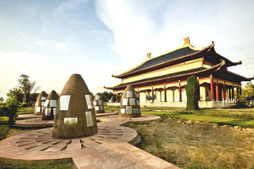
Location: 1 km away from Nalanda.
Importance: This hall has been
constructed in the memory of famous Chinese traveller Hieun-Tsang.
In the 7th century AD (629-645 century AD) Hieun-Tsang toured
India for five years. Beside the hall is ‘Kamal Sarovar’
(lotus pond), which adds to the beauty of the place.
Jagdishpur (Mahamaya Place)
Location: The place is 4 km
away from Nalanda police station and 1.5 km from Nalanda Mahavihar.
Importance: During Buddhist
era a stupa was found at the place. Here 12-feet high stupa
is found and on its top  ‘Mahamaya
Temple’ is established. Today in place is known as Rukmini
Asthan. Inside the temple a black stone statues of Lord Buddha
in ‘Bhoomisparsh’ (ground-touching) posture is
found. The height of statue is 60 inch and is set up on a
58 inch base whose diameter is 160 inch. ‘Mahamaya
Temple’ is established. Today in place is known as Rukmini
Asthan. Inside the temple a black stone statues of Lord Buddha
in ‘Bhoomisparsh’ (ground-touching) posture is
found. The height of statue is 60 inch and is set up on a
58 inch base whose diameter is 160 inch.
The statue is placed inside the womb of the stupa, however,
with the passage of time and natural displacement, it has
surfaced above the ground. Later at the same place the ground
was dug till the base of the statue and a temple was found.
In the vicinity of temple ‘Mridu bhang’ plants
are found. There is agricultural land around the temple. Both
Buddhists and Hindus visited this place all round the year.
This place needs proper development and conservation.

|
